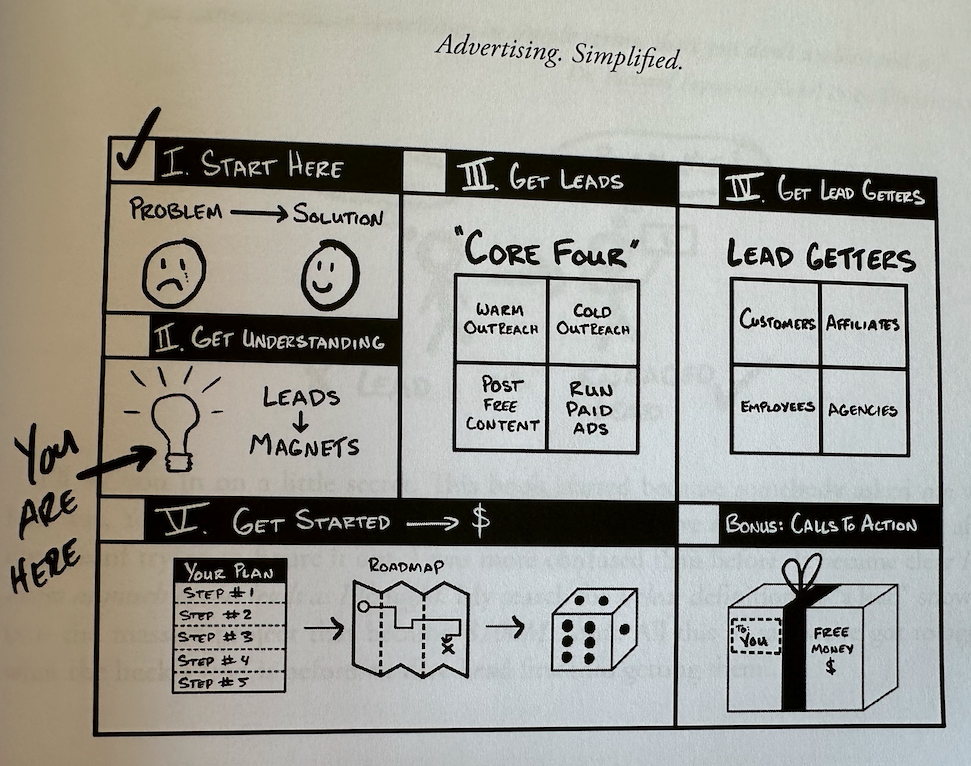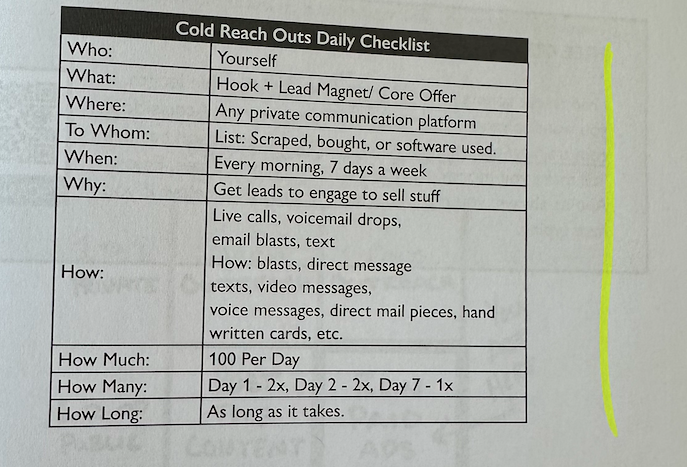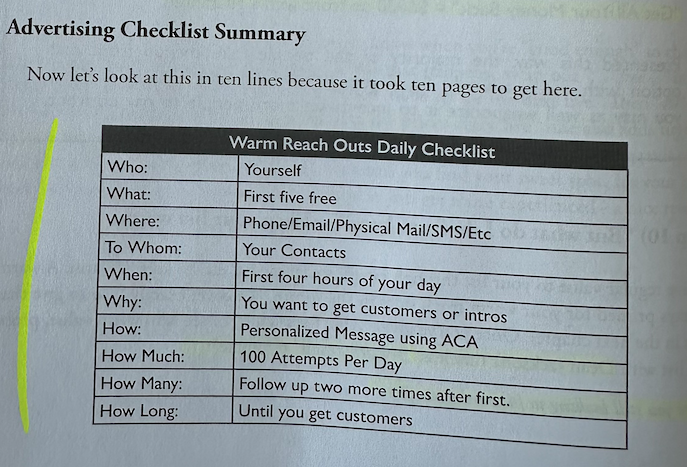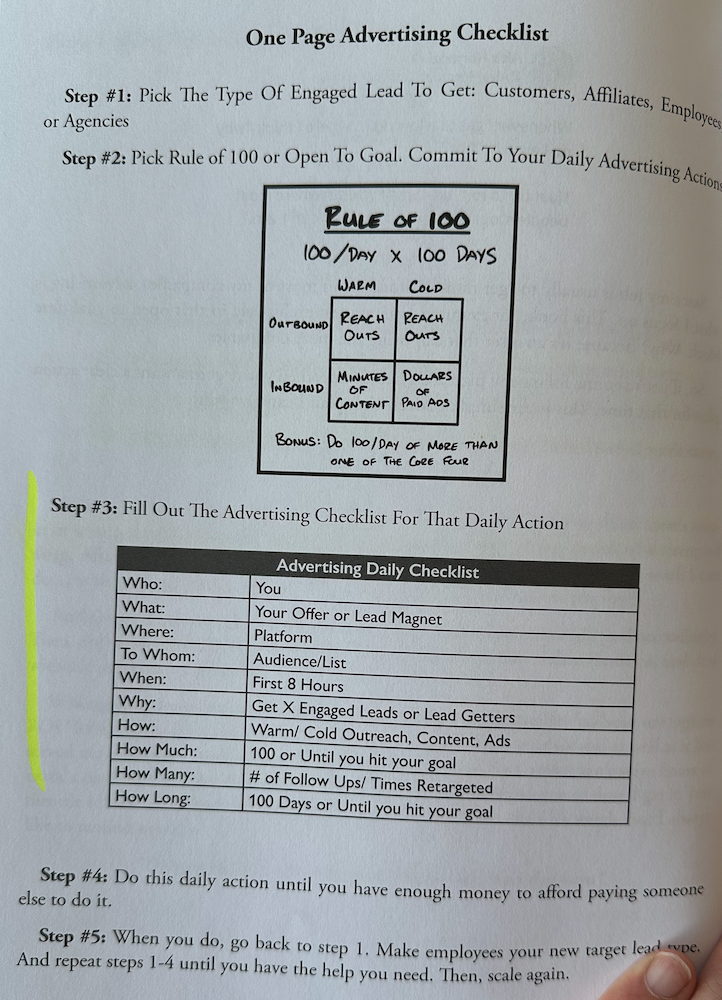Comprehensive Summary of $100M Leads by Alex Hormozi

1. Lead Magnet Fundamentals
A lead magnet is a complete solution to a narrow problem that, once solved, reveals another problem solved by your core offer. The best lead magnets follow these principles:
- Value Exchange: Even free stuff has a cost - time. If your lead magnet isn’t worth their time, it’s overpriced
- Quality: Make your lead magnet so insanely good people feel stupid saying no
- Problem Selection: Pick a problem that’s narrow and meaningful
- Problem-Solution Cycle: Solving one problem should reveal another that your paid offer solves
Three types of lead magnets that work well:
- Solve a recurring problem for a short time with a sample
- Give one step in a multi-step process that solves a bigger problem
- Reveal problems that get worse the longer you wait
Lead magnets can be delivered as:
- Software (tools)
- Information (teaching)
- Services (free work)
- Physical products (samples)
2. Content Creation Strategy
Effective content follows a three-part structure:
- Hook: Get them to notice your content through headlines, curiosity, and relevance
- Retain: Keep them consuming it through lists, steps, and stories
- Reward: Satisfy the reason they consumed it in the first place
Content sources can come from:
- Far Past: Important life lessons
- Recent Past: Things you’ve done or experienced
- Present: Ideas as they happen
- Manufactured: Turn ideas into reality
Effective headlines use elements like:
- Ongoing
- Unusual
- Conflict
- Proximity
- Celebrity
- Recency
- Relevancy
Content length isn’t the issue - “there is no such thing as too long, only too boring”. The key is providing value per second.
3. Audience Building and Monetization
The give-to-ask ratio should be approximately 3.5:1. Give until people ask to buy your products.
Two ways to monetize your content:
- Integrated offers: Add CTAs after valuable moments or at the end of content
- Intermittent asks: Make many pieces of “give” content, then occasionally make an “ask” piece
When building an audience, choose between:
- Depth then width: Maximize one platform before moving to the next
- Width then depth: Get on every platform early, then maximize them together
4. Outreach and Lead Generation
Warm Outreach
The 10 steps for warm reach outs:
- Get your list
- Pick a platform
- Personalize your message
- Reach out
- Warm them up
- Invite their friends
- Make them the easiest offer in the world
- Start at the top
- Start charging
- Keep your list warm
Free customers can make you money in three ways:
- They convert into paying customers
- They send you paying customers via referrals
- Their testimonials bring in paying customers
Cold Outreach
Cold outreach has enormous benefits:
- It’s incredibly reliable
- Fewer platform changes
- You don’t need to create lots of content or ads
- Your competition won’t know what you’re doing
For cold outreach, focus on personalization and big fast value. The fewer leads you have, the less automation you should use.

5. Paid Advertising Strategy
Paid ads are the fastest way to get the most people to see your offer. When creating ads, focus on three key elements:
- Call Outs: Get attention through labels, yes-questions, if-then statements, and contrasts
- Value: Present benefits using the What-Who-When framework
- Calls to Action: Tell them exactly what to do next
For landing pages:
- Make them simple and easy to test
- Use short, memorable web addresses
- Make landing pages match your ads
- Focus on getting contact information
Measure ad efficiency by comparing lifetime gross profit (LTGP) to customer acquisition cost (CAC). Aim for an LTGP/CAC ratio greater than 3:1.

6. Scaling Through Others (Lead Getters)
Four types of lead getters:
- Employees: People in your business that get you leads
- Agencies: Businesses with services that get you leads
- Customers: They buy your stuff then tell others about it
- Affiliates: Businesses who tell their audiences about your stuff
Referrals
Referrals are extremely valuable because:
- They’re worth more (higher LTGP)
- They cost less (lower CAC)
- They buy more expensive products
- They buy more frequently
- They pay in cash
Seven ways to ask for referrals:
- Pay your average CAC to the referrer or the friend
- Discount in exchange for introductions
- Accountability buddy promotions
- Bring-a-friend promotions
- Spouse challenge promotions
- Coach challenge promotions
- Ongoing referral programs with bonuses
Affiliates
For affiliates to work well:
- Find businesses with audiences similar to your customers
- Have them buy your product first (they should believe in it)
- Consider certification programs
- Use a three-tier payout structure
- Pay with product if possible (“Sell 3 Get It Free”)
7. Product Launch Strategy
Use the whisper-tease-shout method:
- Whisper: Create curiosity without revealing the product
- Tease: Reveal the product, launch date, and value elements
- Shout: Give specific actions for the audience when the product launches
8. Business Growth and Productivity
For business growth:
- Underpromise and overdeliver
- Survey customers to find those with best results
- Interview them to find what they did differently
- Force new customers to repeat those actions
- Match guarantee conditions to actions that get results
For productivity:
- Wake up early (4-5am)
- Get right to work (no rituals)
- No meetings until noon
- Focus on uninterrupted work after uninterrupted sleep
9. Core Philosophy
Hormozi’s core philosophy includes:
- “Give away the secrets, sell the implementation”
- “The best way to get them to think they’ll get tons of value after they buy is to provide them with value before they buy”
- “I am compensated tomorrow for the value I provide today”
- “If I can do it, someone else can do it better”
- “Everyone is replaceable, especially me”
10. Advertising Progression Levels
Six levels of advertising progression:
- Your friends know about what you sell (warm outreach)
- You consistently create content and understand how to get leads
- You get employees to help with advertising
- Your product gets consistent referrals (25%+ of customers)
- You advertise in more places in more ways with more people
- You hire killers (top talent)
The key insight: Most people dramatically underestimate the volume it takes to make advertising work. Success comes from doing the right things consistently and at scale.
One Page Advertising Checklist
 1) Pick The Type Of Engaged Lead To Get : Customers, Affiliates, Employees or Agencies
2) Pick Rule of 100 or Open To Goal. Commit To Your Daily Advertising Action
3) Fill Out The Advertising Checklist For That Daily Action
4) Do this daily action until you have enough money to afford paying someone else to do it.
5) When you do, go back to step 1. Make employees your new target lead type. And repeat steps 1-4 until you have the help you need. Then, scale again.
1) Pick The Type Of Engaged Lead To Get : Customers, Affiliates, Employees or Agencies
2) Pick Rule of 100 or Open To Goal. Commit To Your Daily Advertising Action
3) Fill Out The Advertising Checklist For That Daily Action
4) Do this daily action until you have enough money to afford paying someone else to do it.
5) When you do, go back to step 1. Make employees your new target lead type. And repeat steps 1-4 until you have the help you need. Then, scale again.
Follow up
- Acquisition.com/training/leads
- Acquisition.com/avatar
Linking
- [[Highlights_extracted]] - these highlights were a direct extract from images taken from the book with highlighted sections
Notes mentioning this note
There are no notes linking to this note.